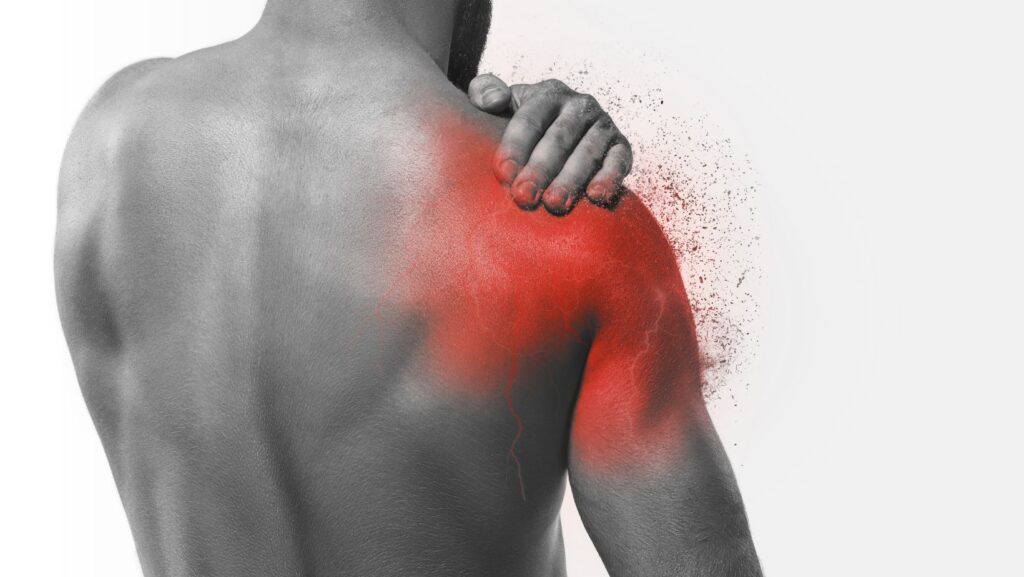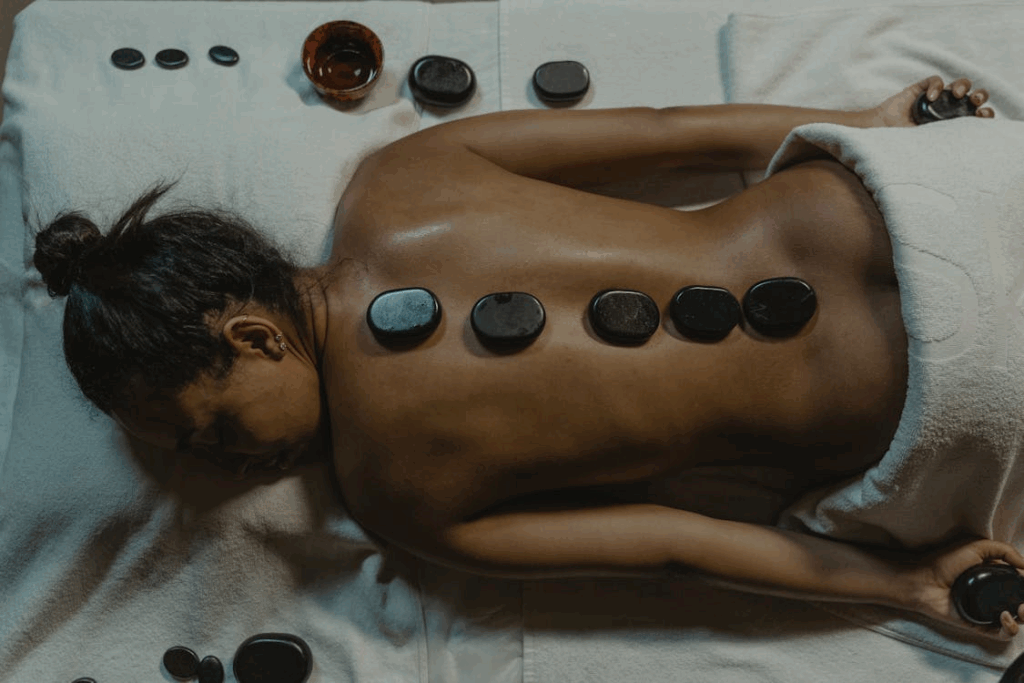Imagine smooth, heated stones gliding over your back, their warmth penetrating deep into tired muscles. This is the magic of hot stone massage, an ancient healing art that transforms ordinary basalt stones into tools for deep relaxation.
Long before modern spas, indigenous peoples around the world understood what science now confirms: heat is medicine. When volcanic stones are placed along the body’s energy lines, something amazing happens. Muscles relax, blood circulation improves, and stress evaporates.
But this is more than a luxury. It is a sophisticated therapeutic technique that addresses issues ranging from chronic pain to anxiety. Discover why millions of people around the world trust this ancient practice.
What is a Hot Stone Massage?
What is a hot stone massage, and why is this technique so different from a regular massage? Essentially, it is a massage therapy method that uses heated stones as the primary tool. Smooth stones are heated to a temperature of 50-60 degrees Celsius and then placed on specific points of the body or used to perform massage movements.
The history of this practice has its roots in ancient cultures:
- Native Americans used hot stones to treat illnesses and relieve muscle tension thousands of years ago.
- Chinese medicine used heated stones to improve the function of internal organs.
- The Japanese developed their own techniques for working with heat.
- Modern hot stone massage combines this ancient wisdom with a scientific understanding of how heat affects muscles and connective tissues.
The basic idea is simple but effective. The heat from the stones penetrates deep into the muscle tissue, causing it to relax faster and deeper than with a regular massage. This allows the therapist to work on the deep layers of muscle without applying as much pressure as in deep tissue massage. For many people, this means receiving the therapeutic benefits without the discomfort.
Hot Stone Therapy – How It Works and Its Benefits
Hot stone therapy works on several levels simultaneously. It not only has a positive effect on health, but also provides a whole range of therapeutic benefits.
The first and most obvious mechanism is vasodilation. In simple terms, when heat is applied to the skin, the blood vessels dilate. This increases blood flow to the area, bringing more oxygen and nutrients to the tissues.
Next, muscle relaxation occurs almost instantly under the influence of heat. When a muscle is heated, it loses tension naturally. The heat allows the therapist to work deeper without the discomfort that usually accompanies deep massage. If you are looking for 대구 출장안마 after long meetings and stress, hot stone therapy may be the ideal choice for quick and effective relaxation.
Additional benefits of hot stones include:
- Improved blood circulation. Dilated vessels allow blood to flow more freely, improving nutrient delivery.
- Relief from chronic tension. Regular sessions can help break patterns of chronic muscle tension.
- Reduced stress and anxiety. The combination of heat and touch activates the parasympathetic nervous system.
- Improved sleep. Many clients report deeper, more restful sleep after sessions.
- Relief of arthritis symptoms. Heat is especially beneficial for stiff, painful joints.
The Tools: Hot Stones and Massage Rocks
Hot stones are not ordinary stones — they are carefully selected for specific characteristics. Basalt is a volcanic rock that is the gold standard for hot stones. These stones are formed from molten lava that cools quickly, creating a dense, fine-grained structure. Basalt has several key advantages: it retains heat exceptionally well, has a smooth texture that does not scratch the skin, and is dense enough to maintain its temperature throughout the session.
Massage rocks come in a variety of sizes and shapes, each for a specific purpose:
- Large stones. Used to place on the back, stomach, or other large areas. They weigh 200-500 grams and provide steady heat.
- Medium stones. These are the workhorses of therapy, held in the therapist’s hands to perform massage movements. They are large enough to be effective but manageable.
- Small stones. Placed between the toes, on the face, or used for precise work on small areas.
- Long flat stones. This tool is ideal for working along the spine or on long muscles such as the quadriceps.
The shape of massage rocks is also essential. Therapists prefer oval or egg-shaped stones. They fit comfortably in the hand and have a natural shape that conforms to the contours of the body. The rocks should be completely smooth, with no sharp edges or rough spots that could cause discomfort.
Caring for hot stones is essential for hygiene and longevity. After each use, the stones are thoroughly washed and disinfected. High-quality basalt stones can last for years with proper care, becoming even smoother with use.
Hot Rock Massage – A Typical Session

Let’s go through a typical hot rock massage session so you know what to expect when you come in for your first treatment.
The session usually begins with a brief consultation. The massage therapist will ask about any medical conditions, areas of tension or pain, and your sensitivity to heat. This is important because some conditions are contraindications for hot rock massage.
You will undress to a level you are comfortable with and lie face down on the massage table, covered with a sheet. Many tables for hot massages have built-in heating, which creates an additional warming effect from below.
The therapist begins by placing stones on key points of your body. Typically, stones are placed along both sides of the spine, following the line of the paravertebral muscles. Additional stones may be placed on the sacrum, in the palms, or between the toes.
For the first few minutes, you lie still, allowing the heat to penetrate your tissues. This is the preparatory phase, where your body begins to relax and your muscles become more pliable.
Then the active phase of the hot stone massage begins. The therapist uses heated stones coated with oil to perform massage movements. The stones glide over the skin in long, smooth strokes, combining heat with mechanical manipulation. The sensation is unique — the heat penetrates deeply while the stone massages the surface.
After working on your back, you will be asked to turn over. The stones may be placed on your stomach, chest, or forehead. Working on the front of the body is usually lighter and more relaxing. The face, neck, arms, and legs receive attention with smaller stones.
The final phase often includes work on the legs and feet. Hot stones are perfect for this area, where many people experience tension. Placing stones between the toes creates a surprisingly pleasant sensation.
The session ends gradually. The stones are removed one by one, and you are given a few minutes to lie there. The therapist may offer you water and recommend that you rest for the rest of the day.
Hot Stone Massage vs. Other Hot Massages
Hot stone massage is not the only form of thermotherapy in the world of massage. Understanding the differences between various hot massages helps you choose the right technique for your needs.
- Traditional hot stone massage vs. bamboo massage. Bamboo massage uses heated bamboo sticks instead of stones. Bamboo is lighter and can roll over the body, creating a different sensation. It is great for deep muscle work because the therapist can apply more pressure through the bamboo stick. However, bamboo does not retain heat as long as basalt stones, so the warming effect is less intense.
- Hot massage vs. Thai herbal massage with compresses. This technique uses heated pouches filled with medicinal herbs. When the hot compresses are pressed against the body, the heat releases the essential oils of the herbs. The body receives an aromatherapeutic effect in addition to the heat. This is an excellent choice for people who appreciate aromas and want to enjoy the benefits of both thermotherapy and phytotherapy. However, stones provide more intense and longer-lasting heat.
- Hot towels are often used in various types of massage to prepare the tissues. They can be placed on the back or wrapped around the limbs. Towels cool down quickly, usually within 5-10 minutes, so their effect is more short-lived. They are good for quickly warming up an area before work.
- Infrared therapy uses special lamps or blankets to generate deep penetrating heat. Infrared heat penetrates deeper into the tissue than the convection heat from stones. This is excellent for detoxification and deep muscle relaxation, but does not provide the tactile element of stones.
The choice between different forms of hot massages depends on your goals. For deep relaxation and muscle tension, hot stone therapy remains unmatched. For more intense deep tissue work, bamboo massage may be better. For an aromatherapy experience, herbal compresses are excellent. Many spas offer combination treatments, allowing you to get the best of several worlds.
Hot stone massage continues to be one of the most popular spa treatments, and it’s easy to see why. The combination of ancient wisdom and modern understanding of physiology creates an experience that is both luxurious and therapeutic.
